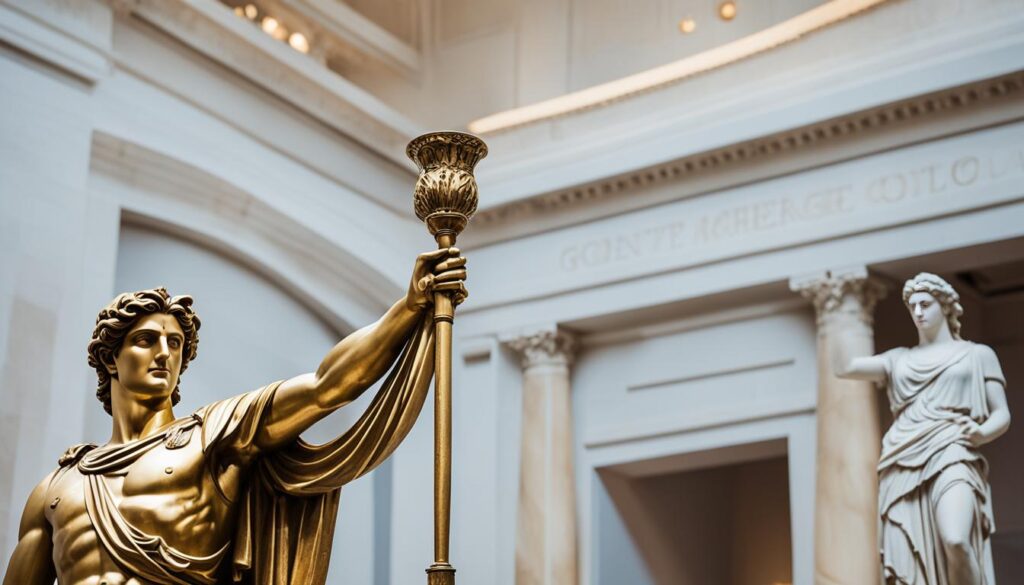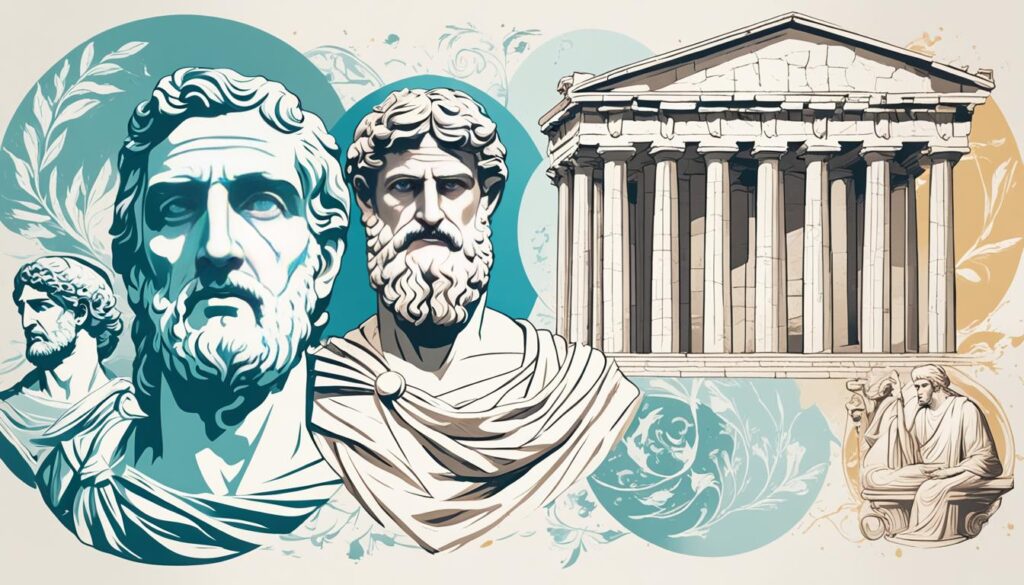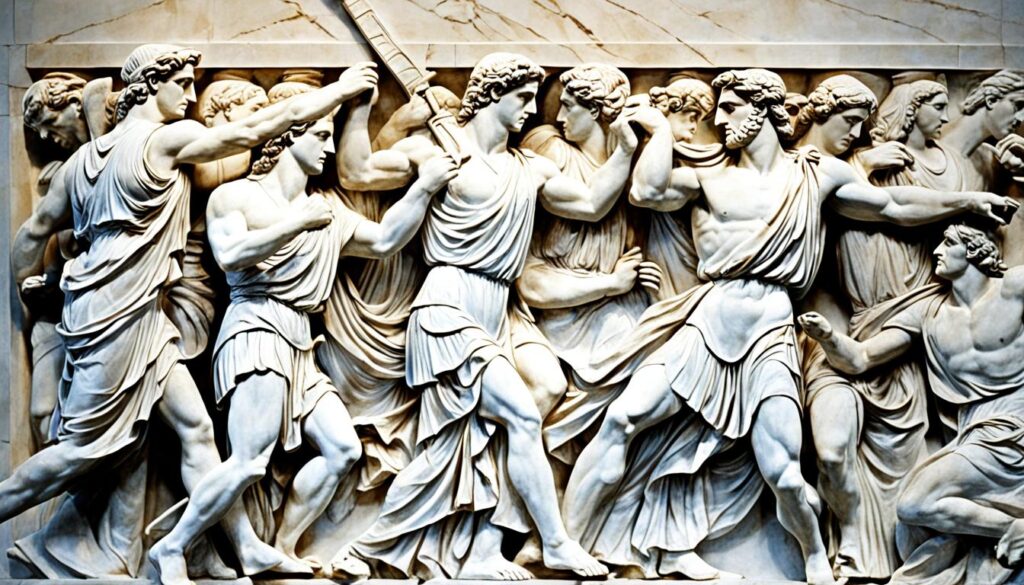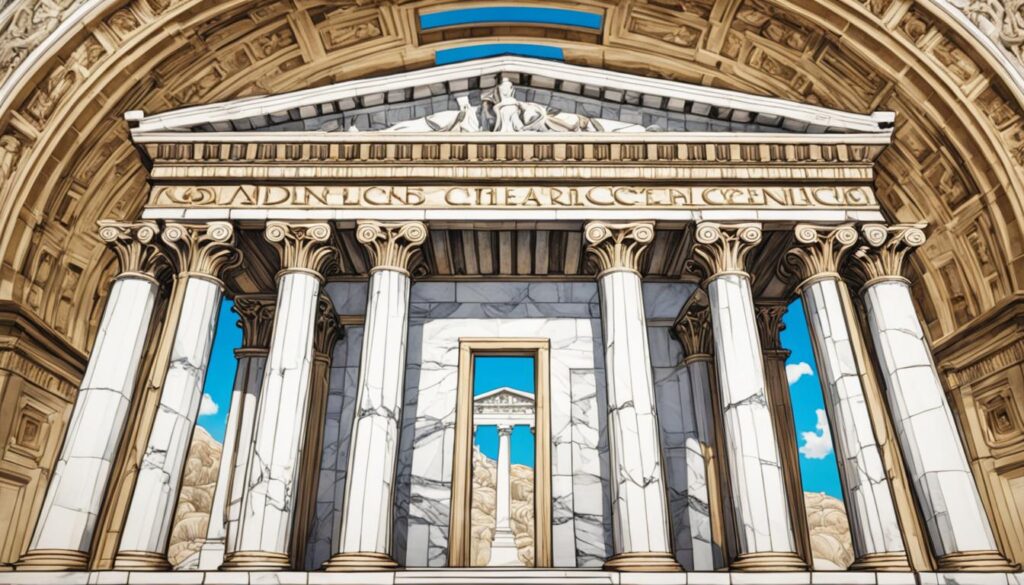The ancient Greece aesthetic is a captivating blend of classical beauty and historical design. It draws inspiration from the rich cultural heritage and artistic achievements of ancient Greece, showcasing elements such as ancient architecture, Greek art, and the timeless appeal of hellenic culture. This aesthetic embodies the enduring legacy of ancient Greece and its contribution to the world of art and design.
Key Takeaways:
- The ancient Greece aesthetic combines classical beauty and historical design.
- It is inspired by the rich cultural heritage and artistic achievements of ancient Greece.
- Ancient architecture, Greek art, and hellenic culture are key elements of this aesthetic.
- The aesthetic represents the enduring legacy of ancient Greece in the world of art and design.
- Its timeless appeal continues to inspire and captivate people today.
The Origins of Art Collection in Ancient Greece
Art collection in Ancient Greece had its origins in the practice of offering art as a form of worship to deities. The term “museum” derives from the Greek word mouseion, which referred to a “seat of the muses.” During the Hellenistic period, sanctuaries became sacred repositories for treasures, playing important roles in rituals and connecting devotees with deities.
This practice involved a meticulous inventory process, with objects categorized based on their function and purpose. These sanctuaries housed objects that exuded both devotional and aesthetic charm.
Art collection in Ancient Greece was deeply intertwined with religious and cultural practices. It began as a means of offering art to gods and goddesses, and gradually evolved into a recognition of the intrinsic value and beauty of these objects. The sanctuaries where these collections were housed served as sacred spaces, connecting believers with the divine.
“The practice of offering art as a form of worship in Ancient Greece laid the foundation for art collection as we know it today. These sanctuaries became the precursors to modern museums, preserving and showcasing both the religious and artistic aspects of ancient Greek culture.”
The meticulous inventory process undertaken by ancient Greeks reflected their appreciation for art and their desire to understand and classify it. Objects were carefully cataloged based on their function and purpose. This systematic approach helped to create a comprehensive understanding of art and its importance in Greek society.
Art collection in Ancient Greece went beyond religious devotion and inventory management. The objects housed in these sanctuaries became representations of Greek culture and heritage. They showcased the artistic achievements and craftsmanship of the time, allowing future generations to appreciate the splendor of ancient Greek antiquities.
The Universal Phenomenon of Collecting
Immanuel Kant, a renowned philosopher, shed light on the universal appeal of art and objects, a concept that is also evident in the ancient Greek antiquarian culture. The collecting practices established during the Hellenistic period continue to exert influence on modern society, shaping the way we approach and value art. Today, art collections thrive in various forms, ranging from curated exhibits in galleries to personal collections curated by individual art enthusiasts.
Immanuel Kant’s theory on aesthetics emphasizes the ability of art and objects to evoke a universal sense of beauty and appreciation, an idea that transcends cultural and historical boundaries. Ancient Greek antiquarian culture recognized the value of art collections, creating a legacy that still resonates today.
“Art collection is a testament to human’s innate desire to preserve and cherish the beauty found in the world. It speaks to our fascination with the past and our yearning for connection with ancient cultures. The ancient Greeks understood this, and their collecting practices have left an enduring impact on the art landscape.”
The legacy of Ancient Greek art collections is seen in the way art is exhibited and valued today. Curated exhibits in galleries provide an opportunity for art enthusiasts to appreciate carefully selected pieces, offering insights into different artistic periods and themes. Personal collections curated by individuals reflect their unique tastes and interests, allowing them to create a visual narrative that speaks to their own artistic sensibilities.
Art Collections: A Glimpse into the Past
Art collections act as portals to the past, granting us intimate glimpses into ancient cultures and their artistic achievements. The legacy of Ancient Greek art collections serves as a bridge that connects our modern world with the rich heritage of the past. By appreciating and preserving these collections, we honor the cultural and artistic accomplishments of ancient Greek civilization, keeping their legacy alive for future generations.
The Influence of Ancient Greek Collecting Practices
The collecting practices of the ancient Greeks have had a lasting influence on the art landscape. These practices encompassed meticulous categorization, inventory management, and the consideration of both the functional and aesthetic aspects of art. These principles continue to shape how we approach art collection and curation today, emphasizing the importance of understanding the context and significance of each piece.
The Legacy Lives On
As we delve into the world of art collections, we are reminded of the profound impact that ancient Greek antiquarian culture has had on the art world. The collecting practices established during the Hellenistic period continue to inspire and inform how we approach and appreciate art. The legacy of the Ancient Greek art collection lives on, reminding us of the timeless beauty and cultural significance that artworks hold.
| Legacy of Ancient Greek Art Collection | Influence |
|---|---|
| Reflection of cultural heritage | Modern society continues to draw inspiration from Ancient Greek artworks, incorporating elements of the classical aesthetic into contemporary design. |
| Curated exhibits | Galleries showcase carefully curated art collections, providing a platform for artists and art enthusiasts to engage with historical and contemporary works. |
| Personal collections | Individual collectors curate personal art collections, reflecting their unique tastes and contributing to the broader art landscape. |
| Ongoing research and preservation | Art historians and scholars continue to study and preserve the art collections of Ancient Greece, ensuring their longevity and accessibility for future generations. |
By exploring the universal phenomenon of collecting and understanding its roots in ancient Greek antiquarian culture, we gain a deeper appreciation for the art that surrounds us. Whether visiting a gallery, curating a personal collection, or studying the ancient artifacts themselves, we connect with the timeless beauty and cultural richness that art offers.

The Enduring Impact of Ancient Greek Collecting Practices
The influence of Ancient Greek practices in art collection continues to shape the contemporary art landscape. The meticulous categorization and appreciation of both the functional and aesthetic aspects of art, as seen in the Hellenistic period, have left a lasting impact. Today, these practices can be observed in how art is approached and valued, whether in curated exhibits or personal collections.
Ancient Greek art collectors were known for their meticulous cataloging and classification of objects based on their function and purpose. This meticulous categorization allowed for a better understanding of the artistic techniques, materials used, and cultural significance of each piece. The careful consideration of both functional and aesthetic aspects ensured that each artwork was valued not only for its beauty but also for its purpose and meaning within the larger cultural context.
As a result, the legacy of Ancient Greek collecting practices can be seen in the way art is displayed and appreciated today. Curated exhibits often showcase art that is organized thematically or chronologically, allowing viewers to understand the context and significance of each piece. Personal collectors, inspired by the aesthetic and cultural values of ancient Greece, often adopt similar cataloging methods to create cohesive and meaningful collections.
“The meticulous categorization and appreciation of both the functional and aesthetic aspects of art, as seen in the Hellenistic period, have left a lasting impact.”
The enduring impact of Ancient Greek practices in art collection is evident in the contemporary art landscape. It has influenced not only the way art is organized and displayed but also the way it is valued and appreciated. The functional and aesthetic aspects of art are both celebrated, allowing for a deeper understanding and connection with the artistic and cultural heritage of ancient Greece.
This enduring influence reinforces the significance of ancient Greek art collection practices and their contribution to the art world. By appreciating the meticulous categorization, functional value, and aesthetic beauty of art, we continue to honor the legacy of ancient Greece and engage with the rich art landscape it has left behind.
Ancient Greece as a Model for Societal Ideals
Ancient Greece continues to captivate present-day society as a model for societal ideals. The enduring legacy of Greek philosophy, democracy, and artistic achievements resonates in contemporary thought and governance. Concepts such as individual rights, civic participation, and the pursuit of knowledge find their roots in Ancient Greek ideals. The Hellenistic traditions of art collection not only serve as historical artifacts but also as timeless inspirations that connect the past with the present, shaping our perceptions of culture, art, and societal values.
One of the most significant contributions of Ancient Greek society is its philosophy, which laid the foundation for Western philosophical thought. Influential philosophers such as Socrates, Plato, and Aristotle explored various subjects, including ethics, politics, metaphysics, and epistemology. Their ideas continue to shape our understanding of morality, justice, and the nature of reality.
Furthermore, Ancient Greece is often referred to as the birthplace of democracy. The democratic principles that emerged in ancient Athens, such as citizen participation, equality before the law, and freedom of speech, have become fundamental pillars of modern democratic systems. The concept of democracy, derived from the Greek words “demos” (people) and “kratos” (rule), underscores the importance of collective decision-making and the involvement of citizens in governance.
Ancient Greek artistic achievements also hold immense cultural significance. From the majestic sculptures of Phidias to the exquisite pottery of the Athenians, Greek art exemplifies timeless beauty and artistic mastery. These artistic creations not only showcased the skill and creativity of the ancient Greeks but also conveyed societal values and ideals. Greek art celebrated the human form, explored mythological narratives, and depicted scenes from everyday life, providing a glimpse into the cultural context of ancient Greece.
The cultural heritage of ancient Greece extends beyond its philosophy, democracy, and art. It encompasses architecture, literature, theater, and sports. Greek architecture, characterized by the use of harmony, proportion, and symmetry, has influenced architectural styles throughout history. The works of Greek playwrights, such as Sophocles and Euripides, have shaped the dramatic tradition, while the Olympic Games, originating in ancient Olympia, symbolize the spirit of competition and collaboration.

“The legacy of Ancient Greece, with its philosophy, democracy, and artistic achievements, continues to inspire and shape contemporary thought and governance.”
Ancient Greece’s impact on societal values is profound and far-reaching. Its emphasis on reason, individualism, and the pursuit of excellence has left an indelible mark on the cultural fabric of Western civilization. The values upheld by ancient Greeks, such as the importance of education, intellectual curiosity, and civic engagement, continue to guide our societies today.
The Hellenistic traditions of art collection complement this rich cultural heritage, providing a tangible connection to the past. Through these historical artifacts, we gain insights into the values, beliefs, and aesthetic sensibilities of ancient Greece. The timeless inspirations derived from ancient Greek art collection help us appreciate and preserve the cultural legacy of this remarkable civilization.
The Elgin Marbles Controversy
The Elgin Marbles controversy centers around the classical Greek sculptures that were once part of the Parthenon in Athens. These magnificent artworks became a subject of heated debate when they were removed by Lord Elgin in the 19th century.
The ongoing controversy over the Elgin Marbles revolves around their rightful ownership and restitution. This contentious issue brings to light the complex intersection between art, politics, and cultural heritage.
The Elgin Marbles controversy goes beyond mere aesthetics, delving into broader issues of identity, heritage, and diplomatic relations. It raises important questions about the significance of art and its role in shaping society.
“The Elgin Marbles controversy is not just about art; it represents the clash of interests, values, and histories. It is a testament to the power of cultural heritage and its ability to ignite fierce debates.” – Art historian
The controversy surrounding the Elgin Marbles adds a compelling and multifaceted layer to the narrative of art collection. It forces us to confront the complexities inherent in the preservation and ownership of cultural artifacts.
The Significance of the Elgin Marbles Controversy
The Elgin Marbles controversy serves as a powerful reminder that art is not divorced from the political and social realities of its time. It highlights the intricate relationship between art, politics, and the cultural heritage of nations.
- The controversy raises questions about the ethical implications of removing cultural treasures from their countries of origin.
- It prompts discussions about the role of colonialism and imperialism in shaping the global art landscape.
- The Elgin Marbles controversy underscores the need for respectful and collaborative approaches to cultural heritage management.
The ongoing debate over the Elgin Marbles challenges us to navigate the delicate balance between historical preservation, national pride, and international cooperation.

The Italian Renaissance Influence
The Italian Renaissance, spanning from the 14th to the 17th century, is often regarded as a golden era in art history. It witnessed an unparalleled flourishing of artistic creativity, with renowned masters like Leonardo da Vinci, Michelangelo, and Raffaello.
The meticulous techniques, attention to detail, and pursuit of perfection exhibited by the Renaissance masters continue to inspire and influence contemporary artists. Their artistic creativity paved the way for new artistic styles, innovative techniques, and groundbreaking ideas that revolutionized the world of art.
“Art is not a thing; it is a way.” – Leonardo da Vinci
The Italian Renaissance masters pushed the boundaries of artistic expression, creating masterpieces that demonstrated their technical expertise and profound understanding of the human form.
Through their work, they immortalized the cultural and historical treasures of their time, capturing the beauty, emotions, and complexities of the human experience.
Their art serves as a testament to the artistic achievements of the Italian Renaissance, leaving a lasting legacy that continues to captivate and inspire artists and art enthusiasts around the world.

Conclusion
The ancient Greece aesthetic, with its classical beauty and timeless appeal, continues to inspire and captivate people today. Drawing from the rich heritage of hellenic culture and artistic achievements, this aesthetic showcases the enduring legacy of ancient Greece. The meticulous art collection practices established during the Hellenistic period have shaped the way we approach and value art, both in curated exhibits and personal collections.
Ancient Greece serves as a model for societal ideals, with its profound impact on contemporary thought and governance. The concepts of individual rights, civic participation, and the pursuit of knowledge find their roots in ancient Greek philosophy and democratic values. The Hellenistic traditions of art collection not only offer historical artifacts but also timeless inspirations, connecting the past with the present and shaping our perceptions of culture, art, and societal values.
Although the Elgin Marbles controversy underscores the intersection between art, politics, and cultural heritage, it reinforces the significance of ancient Greek artworks beyond their aesthetic value. The ongoing debate stimulates discussions on identity, heritage preservation, and diplomatic relations. Furthermore, the influence of the Italian Renaissance, with its unparalleled artistic creativity and pursuit of perfection, serves as a formal model for the contemporary art world, showcasing the preservation of cultural and historical treasures.
By exploring the ancient Greece aesthetic, we embark on a journey that connects us with a timeless charm that transcends centuries. It allows us to appreciate the classical beauty and rich cultural heritage of hellenic culture. With its enduring legacy, ancient Greece continues to leave an indelible mark on the world of art and design, inspiring future generations and ensuring that its timeless appeal persists for years to come.

